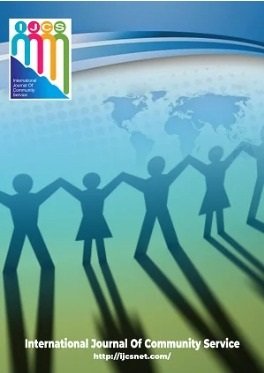Virtual Reality Therapy (VRT) Intervention in Guidance and Counseling Services to Create Violence-Free Schools
DOI:
https://doi.org/10.51601/ijcs.v5i3.891Abstract
School violence, such as bullying and intimidation, remains a crucial issue with a serious impact on student well-being, despite various preventative measures. Conventional guidance and counseling services, which often employ methods such as lectures and group discussions, are considered ineffective in fostering empathy and providing a deeper understanding of the impact of violence. To address this gap, an innovative intervention called Virtual Reality Therapy (VRT) was proposed and implemented. VRT uses realistic simulations, allowing students to experience violent scenarios from multiple perspectives: as victims, perpetrators, and witnesses. The program includes training for guidance and counseling teachers, VR content creation workshops, and implementation support, aimed at improving their technical skills and readiness to adopt the technology. Evaluations using pretests and posttests showed significant improvement. This improvement demonstrates that VRT is an effective and transformative tool for creating safer and more violence-free school environments.
Downloads
References
Nuraini, “Kekerasan Remaja ( Bullying ) di Sekolah Serta Upaya Pihak Sekolah Menanggulanginya : Studi Kasus di SMPN 1 Leuwiliang,” AL-AFKAR J. Islam. Stud., vol. 7, no. 4, p. hlm 1492-1504., 2024, doi: 10.31943/afkarjournal.v7i4.1144..Youth.
S. N. Oktaviani and S. Syawaluddin, “Peran Guru Bimbingan Konseling Dalam Menguatkan Karakter Siswa,” Educ. J. Pendidik., vol. 2, no. 1, pp. 115–119, 2023, doi: 10.56248/educativo.v2i1.120.
T. Setyanawati, “Perilaku Bulliying di Sekolah Menengah Atas,” J. Innov. Reasearch Knowl., vol. 01, no. 5, pp. 1–23, 2023.
“School violence and bullying: global status report,” Sch. violence bullying Glob. status Rep., 2017, doi: 10.54675/POIV1573.
A. Halqim and Rukiyati, “High-Tech Counselor in the Digital Era: Integrating Information Technology into Modern Guidance and Counseling Practices,” J. Sains Sosio Hum., vol. 8, no. 2, pp. 72–82, 2024, doi: 10.22437/jssh.v8i2.39231.
A. Adjorlu, “Virtual Reality Therapy,” Encycl. Comput. Graph. Games, pp. 2053–2059, Jan. 2024, doi: 10.1007/978-3-031-23161-2_244.
A. Y. Chandra, P. T. Prasetyaningrum, O. Suria, P. I. Santosa, L. E. Nugroho, and I. Pratama, “Evaluation User Acceptance of Mobile Virtual Reality Application for English Learning,” 2022 1st Int. Conf. Inf. Syst. Inf. Technol. ICISIT 2022, pp. 283–288, 2022, doi: 10.1109/ICISIT54091.2022.9872873.
O. Suria, A. Yakobus Chandra, and P. T. Prasetyaningrum, “Designing Multi-User Virtual Environment (MUVE) for Learning English Using Virtual Reality Application: Case Study on Senior High School Students in Yogyakarta,” Int. J. Comput. Appl. Technol. Res., vol. 9, no. 10, pp. 283–286, 2020, doi: 10.7753/ijcatr0910.1001.
A. S. Berberyan, H. S. Berberyan, and I. Alsina-Jurnet, “Virtual Reality as Anxiety Management Tool,” Int. J. Cogn. Res. Sci. Eng. Educ., vol. 11, no. 3, pp. 449–459, 2023, doi: 10.23947/2334-8496-2023-11-3-449-459.
N. Jingili, S. S. Oyelere, F. Ojwang, F. J. Agbo, and M. B. T. Nyström, “Virtual Reality for Addressing Depression and Anxiety: A Bibliometric Analysis,” Int. J. Environ. Res. Public Health, vol. 20, no. 9, 2023, doi: 10.3390/ijerph20095621.
D. Kuleli, P. Tyson, N. H. Davies, and B. Zeng, “Examining the comparative effectiveness of virtual reality and in-vivo exposure therapy on social anxiety and specific phobia: A systematic review & meta-analysis,” J. Behav. Cogn. Ther., vol. 35, no. 2, p. 100524, 2025, doi: 10.1016/j.jbct.2025.100524.
J. Y. Mambu, I. G. Purnawindi, R. Luntungan, and S. Mottoh, “ClausTher VR : Virtual Reality untuk Terapi Claustrophobia Reality,” J. Sisforenika, vol. 11, no. 2, pp. 148–160, 2021, [Online]. Available: https://ojs.bibsys.no/index.php/NISK/article/view/462
M. Taffou, “Phobia Treatment through Virtual Reality,” no. c, pp. 1–5, 2021.
E. Aryani and M. Farozin, “Improving Social Skill Through Sosiodrama Technique for Yunior High School Students,” Asian J. Educ. Res., vol. 5, no. 1, pp. 7–20, 2017, [Online]. Available: www.multidisciplinaryjournals.com
M. Gillies and X. ’Sylvia Pan’, “Virtual reality for social skills training,” Proc. Virtual Augment. Real. to Enhanc. Learn. Teach. High. Educ. Conf. 2018, pp. 83–92, 2019, doi: 10.1255/vrar2018.ch9.
P. Kourtesis et al., “Virtual Reality Training of Social Skills in Adults with Autism Spectrum Disorder: An Examination of Acceptability, Usability, User Experience, Social Skills, and Executive Functions,” Behav. Sci. (Basel)., vol. 13, no. 4, pp. 1–37, 2023, doi: 10.3390/bs13040336.
E. Kizhevska, F. Ferreira-Brito, T. Guerreiro, and M. Luštrek, Using Virtual Reality to Elicit Empathy: a Narrative Review, vol. 3425, no. 1. Association for Computing Machinery, 2023.
I. Nurlatifah and R. Sitharan, How Virtual Reality Compares to Other Media for Generating Empathy, vol. 1, no. Iccm. Atlantis Press SARL, 2023. doi: 10.2991/978-2-38476-138-8_24.
P. T. Prasetyaningrum, E. Aryani, and R. Ningsih, “Implementasi Terapi Virtual Reality Sebagai Inovasi Layanan Bimbingan Dan Konseling Di Sekolah Menengah,” JMM (Jurnal Masy. Mandiri), vol. 8, no. 5, pp. 5054–5065, 2024, [Online]. Available: http://journal.ummat.ac.id/index.php/jmm
P. T. Prasetyaningrum, P. Purwanto, and A. F. Rochim, “Gamification on Mobile Banking Application: A Literature Review,” 2022 1st Int. Conf. Inf. Syst. Inf. Technol. ICISIT 2022, pp. 222–227, 2022, doi: 10.1109/ICISIT54091.2022.9873034.
A. Hadi, A. T. Nurbaiti, and E. Aryani, “Pelatihan Art Theraphy dalam Meningkatkan Harga Diri Siswa SMA,” UNITY J. Community Serv., vol. 1, no. 1, pp. 1–4, 2024, doi: 10.70716/unity.v1i1.46.
Downloads
Published
How to Cite
Issue
Section
License
Copyright (c) 2025 Eka Aryani, Salleh Amat, Putri Taqwa Prasetyaningrum, Abdul Hadi, Anifa Tuzzuhroh Nurbaiti

This work is licensed under a Creative Commons Attribution 4.0 International License.


























